
Tempo di Natale, tempo di regali. Una scatola di soldatini sarebbe stata sicuramente un regalo molto apprezzato dai bambini vittoriani di ogni classe sociale.
In passato giocare alla guerra era un classico per i bambini. Gli adulti combattevano conflitti quasi permanenti (la guerra dei 7 anni, la rivoluzione, le guerre napoleoniche, i moti di riunificazione…). I più piccoli inscenavano con i loro soldatini le battaglie, le azioni eroiche oppure facevano rivivere le conquiste delle colonie. Questi giochi di guerra – jeux de guerre per i francesi e Kriegspiel per i tedeschi – formavano i ragazzi e coltivavano il loro patriottismo.
Christmas time is also time for presents. Victorian children of any social class would have loved to receive a box of toy soldiers as a present.
In the past, playing war was a classic for boys. Adults fought in almost continuous conflicts (the 7-year war, the revolution, the Napoleonic wars, the unification…). Children reenacted with their toy soldiers the battles, the heroic actions or the colonial conquests. These war games – “jeux de guerre” for the French, “Kriegspiel” for the Germans – educated the boys and cultivated their patriotism.

soldatini di legno egiziani dell’Antico Regno – Egyptian wooden soldiers from the Old Kingdom – via theancientweb.com
Le prime riproduzioni in miniatura della figura umana risalgano all’antichità. Esse non hanno però uno scopo ludico, ma solo votivo o decorativo. Nell’antico Egitto le statuine di soldati vengono usate dai generali per simulare manovre militari.
I soldatini come giocattolo compaiono solo nel Medioevo. Sono pezzi unici realizzati dagli artigiani. Gli orafi creano figurine in argento o oro per i figli di reali e dell’alta nobiltà. Gli stagnini producono modelli in stagno che sono destinati ai meno abbienti.
Ma è solo nel ‘700 che i soldatini riscuotono grande successo come giocattolo.
The first miniatures of a human figure date back to antiquity. However, the small statues have only votive or decorative purpose and aren’t toys. In ancient Egypt small soldiers are used by generals to simulate military maneuvers.
Toy soldiers appear only in the Middle Ages. These are single pieces made by craftsmen. Goldsmiths create silver or gold figurines for the children of monarchs and aristocracy. Tinker produce tin models for the less wealthy.
But it’s only in the eighteenth century that tin soldiers toys become popular.
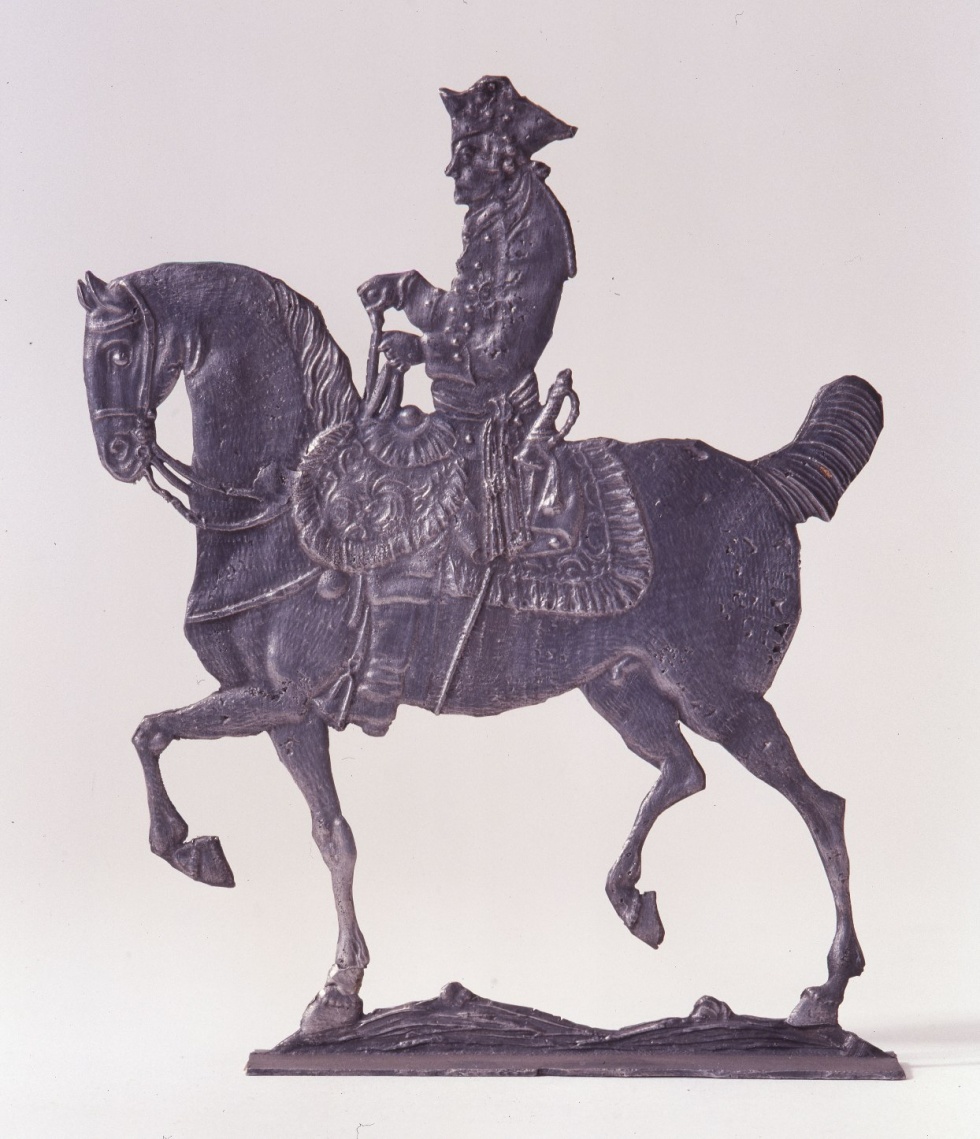
Friedrich II. von Preußen, Friedrich der Große, Zinnfigur – 1770 Deutsches Spielzeugmuseum Sonneberg
Nel XVIII secolo, Norimberga diventa la capitale dei soldatini di stagno, detti in tedesco Zinnfiguren (Zinn = stagno). All’inizio sono figure piatte, appena abbozzate, di varie dimensioni.
Nel 1760 i fratelli Hilpert e figlio aprono la loro attività in questa città. Per circa 100 anni producono figurine di stagno molto elaborate e raffinate. Oggi sono considerate vere opere d’arte e vengono ricercate dai collezionisti.
Lo stagno è un materiale molto utilizzato per la realizzazione dei giocattoli in quest’epoca. Si producono oltre ai pentolini, anche animali da fattoria ed esotici. Ma sono i soggetti militari che riscuotono il maggior successo. Vengono riprodotti non solo personaggi importanti, come re e condottieri, ma anche i loro eserciti e le milizie straniere.
La statuina di Federico il Grande, nella foto qui sopra, è alta 15 cm ed è firmata “J.H.,1777”. Oggi è conservata al Museo Nazionale Bavarese.
In the 18th century, Nuremberg becomes the production center of tin soldiers. In German they are called Zinnfiguren (Zinn = tin). At the beginning the figures are flat, with just some details sketched. They come in different sizes.
In 1760, Hilpert brothers and son start their activity in this city. For about 100 years they produce very elaborate and sophisticated tin figurines. Today, they are considered real masterpieces and are sought after by collectors.
At that time, tin is wildly used for making toys. Beside pots, there are exotic and farm animals. But the military figurines are the most successful. All characters are produced: kings, warlords, their soldiers and the enemies’ troops.
The figurine of Frederick the Great, in the picture above, is 15 cm tall and is signed “J.H., 1777”. Today it is preserved at the Bavarian National Museum.
Iniziano a moltiplicarsi gli artigiani che producono soldatini. Nascono nuove figure professionali come i disegnatori, gli incisori specializzati ed i fonditori. I modelli creati da famosi artisti vengono realizzati con stampi e venduti a prezzi più alti. In Sassonia, ricca di miniere di stagno, inizia la produzione di massa.
The number of craftsmen who produce tin soldiers grows. New professional figures such as designers, specialized engraver and smelter arise. The models created by famous artists are reproduced with molds and sold at higher prices. In Saxony, where there are many tin mines, mass production begins.
Verso la fine del ‘700 le idee di libertà influenzano anche l’educazione dei bambini. Le nuove teorie pedagogiche di Jean Jacques Rousseau in Francia, di Johann Heinrich Pestalozzi in Svizzera, di Gottfried von Herder e Christian Gotthilf Salzmann in Germania, s’ispirano a questi ideali. L’apprendimento deve avvenire anche tramite il gioco e le figure di stagno hanno un ruolo importante.
Towards the end of the 18th century, the ideal of freedom influences also children’s education. The new pedagogical theories of Jean Jacques Rousseau in France, Johann Heinrich Pestalozzi in Switzerland, Gottfried von Herder and Christian Gotthilf Salzmann in Germany are inspired by this ideal. Learning takes place through the game and tin figures have an important role.
Il gioco non deve però solo educare, ma anche informare. In un’epoca dove le notizie circolano molto lentamente o per niente, l’interesse per l’attualità è grande. Così i produttori di soldatini cercano di battere la concorrenza offrendo giochi che facciano riferimento ad accadimenti del momento. I temi d’attualità che riscuotono grande interesse, oltre alle battaglie, sono le spedizioni, le scoperte scientifiche e la conquista delle colonie.
The game should not only educate, but also inform. At that time news circulate very slowly or not at all. So the interest in current events is great. The tin soldiers’ producers try to beat the competition by offering sets that refer to the latests events. In addition to recent battles, actual topics, such as expeditions, scientific discoveries and the conquest of colonies, meet the interest of customers.

Figurines de bois polychromes par Jean-Baptiste Clémence (Paris; 1743-1801):dragons – Musée de la figurine historique à Compiègne
A fianco delle figure piatte, rappresentate di profilo, iniziano a circolare quelle più scultoree e rapidamente le statuine piene a tutto tondo le sostituiscono. Le dimensioni variano da 3 cm ai 20 cm, anche se quest’ultima è rara.
Queste nuove forme sono prodotte da ditte come Spenkuch, Haffner o Heinrich. Oltre allo stagno compare anche il piombo, che intorno al 1871 diventa il materiale più utilizzato, soprattutto in Francia ed Austria.
Next to the flat figures, that show only the profile, fully rounded three-dimensional soldiers appear and quickly replace the flat-ones. The size varies from 3 cm to 20 cm, although the latter is rare.
This new type is produced by companies like Spenkuch, Haffner or Heinrich. In addition to the tin, lead appears. Around 1871 it becomes the most used material, especially in France and Austria.
I soldatini si diffondo in tutta Europa. In Italia compaiono nel 1770. Nel 1830, l’artigiano Carlo Ortelli Dotti emigra a Barcellona e lì inizia a realizzare con grande successo soldatini di piombo. La Spagna diventa un altro importante centro di produzione.
Toy soldiers spread throughout Europe. In Italy they appear in 1770. In 1830, the Italian craftsman, Carlo Ortelli Dotti, emigrates to Barcelona. Here he starts a successful production of lead soldiers. Spain becomes another important manufacturing site.
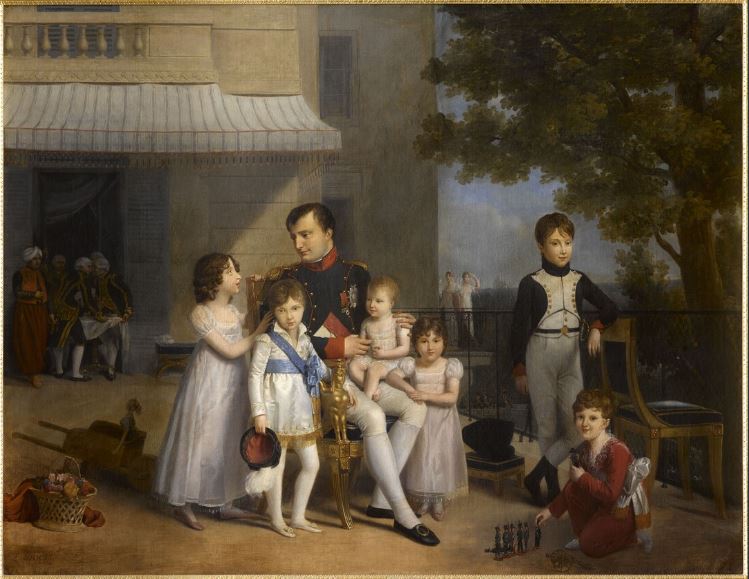
Napoléon avec des jeunes princes et princesses de sa famille – Louis Ducis – 1810 © Photo RMN-Grand Palais – G. Blot
In Europa altre ditte conosciute che producono soldatini sono Pfeiffer in Austria e CBG Mignot (prima Cuperly, Blondel e Gerbeau) e Lucotte. in Francia.
In Europe other well known companies that manufacture toy soldiers are Pfeiffer in Austria and CBG Mignot (before Cuperly, Blondel and Gerbeau) and Lucotte in France.
A partire dal 1840 le dimensioni vengono standardizzate a 3 cm, così da poter sistemare molte divisioni militari e ricostruire intere scene di battaglia.
Since 1840 dimensions are standardized to 3 cm. So it’s possible to arrange many military divisions and recreate entire battle scenes.
Nel 1893 la ditta britannica William Britain Ltd rivoluziona la produzione dei soldatini introducendo la figura a tutto tondo, ma cava. Il processo prevede che dopo aver versato il piombo fuso nello stampo, prima che il metallo si rapprenda completamente, si faccia fuoriuscire una parte del piombo. Si ottiene così una figura perfettamente formata all’esterno, ma vuota all’interno. Questo procedimento permette di risparmiare materiale di produzione ed abbassare i prezzi. I soldatini W. Britain sono quindi più leggeri e più economici di quelli delle concorrenza tedesca.
Il soldatino cavo diventa il più venduto nel Regno Unito e negli Stati Uniti d’America .
In 1893, the British toy company William Britain Ltd changes the way to produce toy soldiers by introducing hollow figures. After pouring the cast lead into the mold, before the metal becomes fully solid, a part of the lead is poured out. So the outside of the figure is perfectly formed, but inside is empty. This process saves production material and lowers the prices. Thanks to the method of hollow casting, the soldiers are lighter and cheaper than the German counterparts.
The hollow lead soldier becomes a best seller in the UK and the US.
A partire dalla metà del 19 secolo vengono prodotti eserciti di soldati di ogni paese con divise ed accessori ricchi di dettagli. Le figure sono in posizioni diverse: in ginocchio, in piedi, sdraiati a terra o a cavallo.
Nel 1871 la guerra tra Germania e Francia fa registrare un boom nella produzione dei soldatini. La vittoria contro i francesi e le tensioni alla viglia della prima guerra mondiale portano al rialzo del mercato dei soldatini. Solo nella zona di Norimberga, sono centinaia le donne impiegate a dipingere i soldatini.
Since the middle of the 19th century, the toy soldiers are produced with uniforms of all nations and the clothes and accessories really detailed. The figures are in different positions: kneeling, standing, on horseback or lying on the ground.
In 1871 the war between Germany and France marks a boom in the production of toy soldiers. The victory against the French army and the tensions before the outbreak of the First World War lead to growth of the soldiers’ market. At that tome, only in the Nuremberg area, there are hundreds of women employed to paint soldiers.
Questa scatola di soldatini contiene le figure che rievocano la guerra del 1904/1905 tra Giappone e Russia, la prima vinta da una potenza asiatica contro una europea. E’ stata prodotta in Germania nel 1906 da Georg Spenkuch. La sua ditta, la Nürnberger Zinn-Compositions-Figuren-Fabrik, fondata nel 1864, ha vinto parecchie medaglie, come si vede dall’etichetta sul coperchio.
This box of tin soldiers contains figures recalling the 1904/1905 war between Japan and Russia. This was the first time that an Asian military force won over an European. It was produced in Germany in 1906 by Georg Spenkuch. His company, the Nürnberger Zinn-Compositions-Figuren-Fabrik, founded in 1864, won several medals, as you can seen from the label on the cover of the box.
I soldatini di stagno vengono realizzati usando uno stampo di ghisa composto da due parti. Le due metà vengono serrate insieme e riscaldate. Si fa fondere lo stagno a 300 ° C e poi lo si cola dentro l’apertura superiore dello stampo.
Una volta che il metallo si è raffreddato e solidificato, si apre lo stampo e si stacca la figurina. Si elimina l’eccedenza della colata, in corrispondenza dell’apertura e si ripuliscono i bordi delle figurina. Infatti in corrispondenza della giunzione delle due parti dello stampo si formano delle sbavature, che si eliminano con una lima.
I soldatini di piombo sono realizzati con una lega di piombo e antimonio. Oggi i giocattoli di piombo non possono essere dati ai bambini, per via della tossicità di questo metallo.
Tin soldiers are made using a cast iron mold made up of two parts. The two halves are clamped together and heated. The tin is melted at 300 ° C and then poured into the upper opening of the mold.
Once the metal has cooled down and solidified, the mold is opened and the figurine is removed. The excess of casting is eliminated at the opening. The edges of the figurine are cleansed with a file. This is necessary in order to eliminate the sprues left over in correspondence of the junction of the two mold halves.
Lead soldiers are made with an alloy of lead and antimony. Today, children are not allowed to play with lead toys because of the toxicity of this metal.
Alla fine dell’Ottocento fiorisce anche il mercato degli stampi per realizzare da se i propri soldatini di piombo o stagno. Famosa è la ditta Gebrüder Schneider di Lipsia che dal 1904 al 1940 riscuote grande successo.
Regolarmente pubblicano cataloghi con le illustrazioni dei soggetti disponibili. Qui sono raccolti in un elenco con le illustrazioni di alcuni dei prodotti finiti. La dimensione delle figure raffigurate corrisponde approssimativamente a quella dell’originale.
At the end of the nineteenth century, children start to make their own tin soldiers at home and the molds market flourishes, too. Gebrüder Schneider, is a famous mold company in Leipzig and it is very successful from 1904 to 1940.
They regularly publish catalogs with illustrations of their products. Here are listed some illustrations of their finished items. The size of the figures on the catalogue corresponds roughly to that of the original.
I materiali con i quali sono stati costruiti i soldatini sono i più vari e sono legati all’epoca alla quale appartengono: legno, carta, stagno, piombo, latta, carta, gesso, cartapesta, plastica e gomma.
Certamente la versione dei soldatini più semplice è quella di carta. In Italia il primo foglio di soldatini di carta è stato stampato da Remondini, nel 1772. Questa famiglia di stampatori di Bassano del Grappa era famosa in tutto il mondo per le stampe di Santi ed eroi, per i giochi, come ad esempio quello dell’oca, per le stampe con le vedute e bellissime carte speciali, come quelle marmorate, e le carte da parati. Essi stampano anche libri e pubblicano i primi romanzi popolari a puntate.
A partire dalla fine del XVIII secolo I Remondini producono un vasto assortimento di soldatini. I fogli rappresentano soldati prussiani, austriaci, inglesi, russi e francesi, a piedi o a cavallo.
Le figure sono impresse, con matrici di rame, su fogli di carta o cartoncino. Il colore è poi applicato dipingendo a mano, oppure con la stampa.
Data la delicatezza del materiale, non si sono purtroppo conservati gli esemplari più antichi, che così sono andati persi.
Toy soldiers could be made of various materials depending from the period they belong: wood, paper, tin, lead, paper, plaster, plastic and rubber.
The simpler version of toy soldiers is made of paper. In Italy, the first sheet of paper soldiers is printed by Remondini in 1772. This family of printers, based in Bassano del Grappa (Veneto), was famous all over the world for their prints of saints and heroes, for paper toys, like the game of the goose, for prints of vedute (landscape images), for their wallpapers and beautiful special papers, like the marbled ones. They also printed books and published serialized novels.
From the end of the 18th century Remondi produce a wide assortment of soldiers: Prussian, Austrian, English, Russian and French, on foot or on horseback.
The figures are printed on sheets of paper or cardboard with copper matrices. Color is then applied by hand or by print.
Unfortunately, the oldest samples have not been preserved until our days, as the material is extremely delicate.
I bambini, prima di ritagliare le figure con precisione, incollavano i fogli su carta o cartoncino per rinforzarle.
Con i soldatini più pesanti si giocava a lanciarli contro il muro. Chi colpiva di rimbalzo un’altra figurina, la poteva “catturare” e farla sua.
Mentre quelli più leggeri venivano lasciati cadere a terra. Vinceva chi possedeva il soldatino che era atterrato con l’immagine rivolta verso l’alto. Come premio poteva prendere i soldatini caduti capovolti.
The children glued the soldiers on paper or cardboard to reinforce them. Then they cut them out with precision.
They played different games with them. They threw the heavier soldiers against a wall. Those who struck another figurine with a bounce, could “capture” it.
While the lighter ones were dropped to the ground. The winner was the one who owned the soldier that had landed with the image facing up. As a prize he could take the other soldiers fallen face down.
Dopo la prima guerra mondiale, le battaglie perdono il loro fascino. Nessuno vuole più evocare combattimenti e sconfitte ed il mercato dei soldatini crolla drasticamente.
Nemmeno il boom dei giocattoli di latta degli anni ’50 e ’60 riporterà in auge i soldatini come gioco.
Oggi sono gli adulti e gli adolescenti a costruire modelli di soldati. Li ambientano in diorami oppure fanno giochi di simulazione. I soldatini di stagno non fanno più parte del mondo infantile, ma sono diventati pezzi da collezionismo.
After the First World War, battles loose their charm. No one wants to evoke battles and defeats. The soldiers’ market collapses drastically.
Not even the boom of tin toys in the 1950s and 1960 brings the toy soldiers back to its previous popularity.
Today, adults and adolescents build soldiers’ models. They place them in dioramas or do simulation games. Tin soldiers are no longer part of the infant world and have become collectibles.

Quando ho visto per la prima volta gli stuzzicadenti con una parte intagliata, ho subito pensato a quanto questa assomigli a dei soldatini.
Questo modello di stuzzicadenti è chiamato Giapponese. Ho scoperto che la parte finale ha una funzione e non è prettamente decorativa. Le scanalature aiutano a spezzare il legno. Una volta staccata l’estremità, la si usa come supporto per lo stuzzicadenti, così che la punta non tocchi il tavolo. Trovo quest’idea orribile, così come l’uso in pubblico dello stuzzicadenti per l’igiene orale. Rimane però un versatile materiale per miniaturisti.
When I saw for the first time toothpicks with one end carved, I immediately thought how much this part looks like a toy soldier.
This toothpick model is called Japanese. I discovered that the final part has a function and it’s not just a decoration. The grooves enable to snap off the end. Once detached, it supports the toothpick so that the tip doesn’t touch the table. This is a horrible idea for me, as well as the use of toothpicks for oral care at the table. But toothpicks remain a versatile material for miniaturists.

Così ho pensato di farne un gioco per i bambini della casetta delle bambole. Li ho dipinti con il pennarello indelebile: rosso per la giubba e nero per i pantaloni ed il colbacco. Si possono realizzare diverse truppe con colori differenti.
So I thought I could use them to make a toy for the dollhouse. I painted them with the permanent marker: red for the jacket and black for the pants and the busby. But you could make different troops with different colors.

Staccare il soldatino dallo stuzzicadenti è abbastanza facile. Ho appoggiato la lama del cutter nella scannellatura sotto il piede della figurina ed ho fatto rotolare il legno sottostante fino a quando si è staccato. Ho poi scartavetrato la base per renderla perfettamente piana.
It’s quite easy to cut off the soldier from the toothpick. I put the blade of a cutter in the clipping under the foot of the figurine and rolled the wood underneath until it detached. Then I sanded the base to make it perfectly flat.

Ho preparato diversi soldatini.
I made several soldiers.

Per aggiungere qualche dettaglio, ho deciso di fare una bandoliera bianca. Non essendo molto brava con i pennelli, ho tagliato delle striscioline di carta abbastanza sottili. Ne ho incollato una parte dalla spalla al fianco opposto. Volendo si potrebbe darla girare anche sul retro.
To add some detail, I decided to make a white bandolier. I’m not very good at painting, so I cut thin strips of paper. I’ve glued a part starting from one shoulder to the opposite hip. If you wish, you can turn it also on the back.

Poi ho incollato una striscia di carta tutta attorno alla vita per fare la cintura.
Then I glued a strip of paper around the waist to make the belt.

I soldatini nella loro uniforme sono pronti. Allineati nella loro scatola fanno proprio una bella figura.
The toy soldiers in their uniform are ready. Aligned in their box they look really good.

Per la realizzazione della scatola ho usato il legno di una confezione di un formaggio francese. Il legno è abbastanza sottile da essere in scala per i soldatini.
To make the box I used a wooden packaging of a French cheese. The wood is thin enough to be on scale for the soldiers.

Con cautela ho staccato il bordo usando un leva graffette.
Carefully I detached the border using a stapler remover.

Ne ho tagliato un pezzo ed ho appoggiato i soldatini sul legno per stabilire la misura della base della scatola. Poi l’ho tagliato usando il cutter ed un righello di metallo come guida.
La mia base misura 19 mm x 14 mm.
I cut a piece of wood and I put the soldiers on it to determine the size of the bottom of the box. Then I cut the piece using a cutter and a metal ruler as cutting guide.
The bottom of my box measures 19 mm x 14 mm.

Ho poi tagliato una striscia di legno alta 5 mm per il bordo della scatola. Ho ricavato i due lati corti, larghi come la base. I miei bordi corti misurano 14 mm x 5 mm.
Ho incollato i bordi al fianco della base e non sulla base, così i bordi della scatola sono puliti, senza giunture visibili.
Then I cut a 5mm high strip of wood for the border of the box. I made two for the short sides. They are as wide as the base. Mine measure 14 mm x 5 mm.
I glued the edges to the side of the base and not on the base. So the borders of the box are clean and there are no visible joints.

Il bordo più lungo è sulla parte frontale della scatola e copre lo spessore dei bordi laterali. Ogni mio bordo lungo misura 21 mm x 5 mm.
The long borders are on the front of the box and cover the thickness of the side borders. Each of my long side measures 21 mm x 5 mm.

Qui si vede bene che i bordi sono stati incollati a fianco della base e a filo del fondo.
Here you can see that the borders are glued to the sides of the base, flush to the bottom.

Per applicare la colla vinilica ho usato uno stuzzicadenti, che mi ha permesso di prenderne la giusta quantità e metterla esattamente dove volevo per coprire bene tutti i bordini, senza sbavare.
To apply the vinyl glue I used a toothpick. This allowed me to take the right amount of glue and to spread it only where I wanted, to cover all the sides of the border without smudging.

La scatola è quindi pronta.
So the box is ready.

Per il coperchio ho ritagliato un rettangolo dello stesso legno, grande come la scatola compresi i bordi.
For the lid I used the same wood. I cut a rectangle as big as the box, including the borders.

Il coperchio deve coprire completamente la scatola ed arrivare a filo del bordo.
The lid must completely cover the box and be flush to the border.

Per far sì che il coperchio si incastri nella scatola, ho ritagliato due piccole stecche, grandi come il coperchio meno due volte lo spessore del bordo. Ogni stecca misura 19 mm x 1 mm x 1 mm.
To make the lid stuck to the box, I cut two small sticks. They must be as large as the lid less two times the thickness of the boarder. Each stick measures 19 mm x 1 mm x 1 m.

Le ho incollate sull’interno del coperchio a 1 mm di distanza dei bordi.
I glued them to the inner side of the lid, leaving a gap from the borders of 1 mm.

Una volta calzato il coperchio sulla scatola, questo si incastra e non si muove, rimanendo serrato.
Once the lid is put on the box, it fits perfectly. It doesn’t move and stays closed.

Infine ho stampato l’etichetta, che troverete più avanti. L’ho ritagliata ed incollata sul coperchio. Ora la scatola è pronta per accogliere i soldatini. Poi potrà essere incartata in una bella carta e sistemata sotto l’albero di Natale.
Finally I printed the label. You will find it later. I glued the label on the lid. Now the box is ready for the toy soldiers. Then it can be wrapped in a nice paper and put under the Christmas tree.

Nel passato i giochi erano confezionati sia in scatole di legno che in cartone. Per questo ho creato anche una scatola per i soldatini di carta.
In the past, toys were packed in both wooden and cardboard boxes. So I also designed a paper box for the toy soldiers.

Potete scaricate il pdf qui insieme all’etichetta per la scatola di legno. Ho stampato e ritagliato la scatola ed il suo coperchio.
You can download the pdf here, together with the label for the wooden box. I printed and cut out the box and its lid.

Ho piegato i bordi aiutandomi con una lama dritta (qui vi mostro come). Questo metodo permette di imprimere una piega diritta e pulita.
I bent the edges. To get a perfect and neat crease, I used a straight blade (here I show you how I do it).

Poi ho steso la colla sulle linguette. Li ho pressati bene insieme, aiutandomi con la punta di uno stuzzicadenti pulito, così d’arrivare bene dentro agli angoli.
Then I applied the glue to the flaps and pressed them together. With the tip of a clean toothpick I reached inside the corners.

La scatola di carta è così pronta.
The paper box is now ready.

Augurandovi Buone feste a Voi ed alle Vostre famiglie, Vi lascio con Il soldatino di stagno, la fiaba che Hans Christian Andersen scrisse nel 1838 e che racconta le disavventure di un coraggioso soldatino con una gamba sola, innamorato di una ballerina di carta.
C’erano una volta venticinque soldati di stagno, tutti fratelli tra loro perché erano nati da un vecchio cucchiaio di stagno. Tenevano il fucile in mano, e lo sguardo fisso in avanti, nella bella uniforme rossa e blu. La prima cosa che sentirono in questo mondo, quando il coperchio della scatola in cui erano venne sollevata, fu l’esclamazione: «Soldatini di stagno!» gridata da un bambino che batteva le mani; li aveva ricevuti perché era il suo compleanno, e li allineò sul tavolo.
I soldatini si assomigliavano in ogni particolare, solo l’ultimo era un po’ diverso: aveva una gamba sola perché era stato fuso per ultimo e non c’era stato stagno a sufficienza! Comunque stava ben dritto sulla sua unica gamba come gli altri sulle loro due gambe e proprio lui ebbe una strana sorte.
Il resto della fiaba potete continuare a leggerlo qui
Wishing you Merry Christmas to you and your families, I leave you with The steadfast tin soldier, the fairy tale written by Hans Christian Andersen in 1838. It tells the misadventures of a brave soldier with only one leg, in love with a paper ballerina.
There were once twenty-five tin soldiers, who were all brothers, for they were cast out of one old tin spoon. They held their muskets, and their faces were turned to the enemy; red and blue, ever so fine, were the uniforms. The first thing they heard in this world, when the cover was taken from the box where they lay, were the words, “Tin soldiers!” A little boy shouted it, and clapped his hands. He had got them because it was his birthday, and now he set them up on the table. Each soldier was just like the other, only one was a little different. He had but one leg, for he had been cast last, and there was not enough tin. But he stood on his one leg just as firm as the others on two, so he was just the one to be famous.
You can read the rest of the story here
Questo progetto fa parte del Calendrier de l’Avent 2017 organizzato da Joc, che ringrazio di cuore per aver inserito anche quest’anno un mio tutorial nel suo bellissimo calendario.
Se non l’avete ancora fatto, andate alla pagina del Calendario dell’Avvento e scoprite, giorno dopo giorno, tutte le sorprese che sono celate dietro alle finestrelle numerate.
This project is part of the Calendrier de l’Avent 2017 organized by Joc. Many thanks for including also this year my tutorial in her beautiful calendar.
If you haven’t done it yet, go to the Advent Calendar page and discover day after day all the surprises that are hidden behind the numbered doors.

SalvaSalva
SalvaSalva
SalvaSalva
SalvaSalva
SalvaSalva



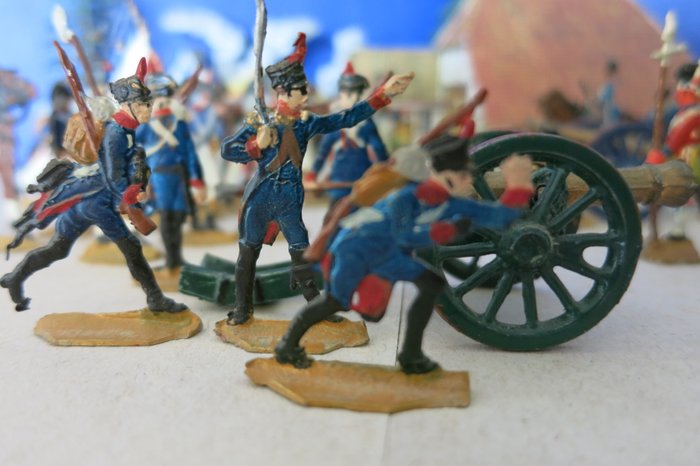









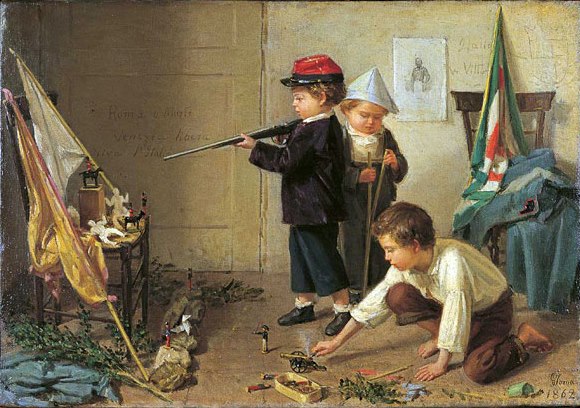









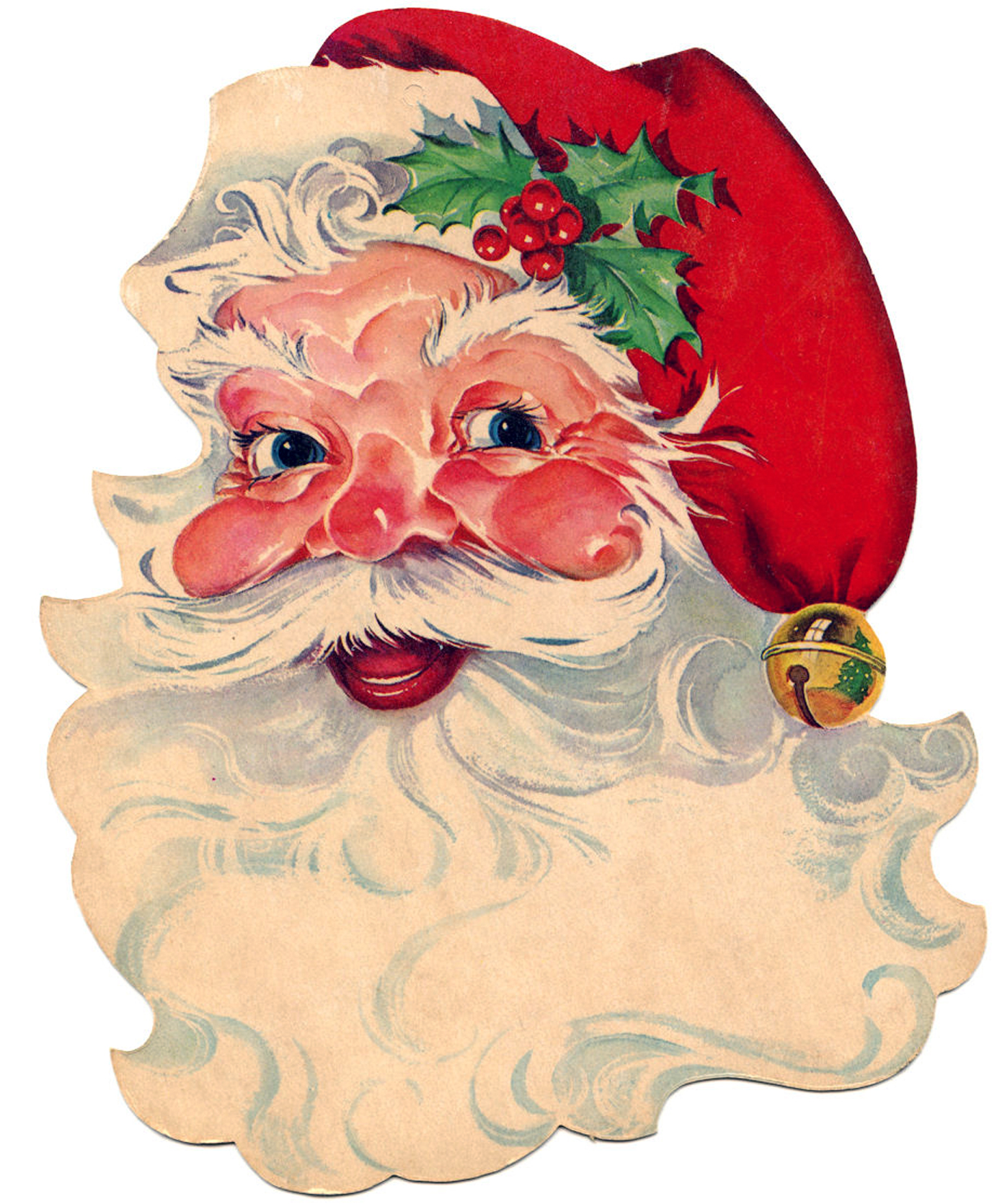

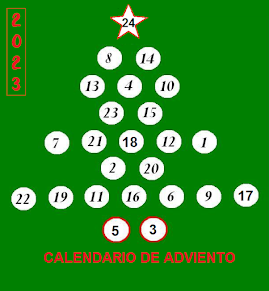










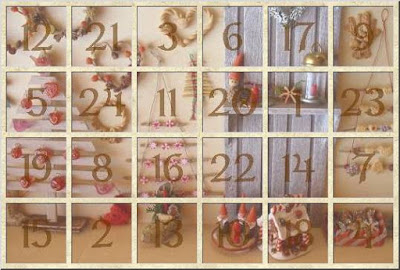
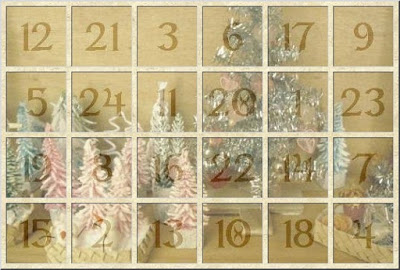












La scatolina con i suoi bei soldatini tutti impettiti e allineati è magnifica ❤
Sotto l'alberello natalizio fa un figurone!
Adoro i "piatti" di Norimberga. La storia dei soldatini di piombo è interessantissima.
Oggi il modellismo/collezionismo dei soldatini è specializzato e attivo, anche se i produttori con gli anni si sono ridotti in numero e qualità 😀
Vi auguro un sereno e festoso Natale ❤
Bacio
Sid
"Mi piace"Piace a 1 persona
Cari auguri anche a te Sid! 🎄❤️🎄
"Mi piace"Piace a 1 persona
❤
"Mi piace"Piace a 1 persona
Ersilia, nicht nur sind Anleitung und Ergebnis super süß, sondern auch der Artikel und die Recherche, die dahinter steckt, wirklich beeindruckend. Toll gemacht, sehr informativ…. muss ich unbedingt meinem Mann zeigen, er besitzt noch seine tolle Zinnsoldaten aus der Kindheit (und ein Far-West Fort mitsamt Cowboys and Indianer auch :-))
Das Märchen, jedoch, habe ich mir für später aufgehoben. Andersen stimmt mich immer so melancholisch…
Wünsche Dir ein besinnliches Weihnachtsfest und Guten Rutsch ins nächste Jahr!
Marina
"Mi piace"Piace a 1 persona
Danke Marina! Es freut mich, dass Du den neuen Post toll gefunden hast. Ich hoffe, dass der Text nicht zu lang wirkt. Die Informationen, die ich gesammelt habe waren so interessant, dass sie die Oberhand genommen haben. 😉
Vielen Dank für Deine Wünsche, die ich gerne erwidere!
Ersilia
"Mi piace""Mi piace"
El artículo es muy interesante con tanta información y gracias por este tutorial tan completo.
Ha quedado un hermoso juguete para regalar.
Un abrazo
"Mi piace""Mi piace"
Grazie Marian! 🙂
Ti auguro Buon Natale
Ersilia
"Mi piace""Mi piace"
Gracias por compartir todo ese conocimiento con nosotros. Tu tutorial es magnifico, gracias por la idea. Un saludo y Feliz Navidad
"Mi piace"Piace a 1 persona
Grazie per il gentile commento 🙂 Sono contenta che il mio tutorial ti sia piaciuto. Mi scuso per il ritardo con il quale ti rispondo. Colgo quindi l’occasione per augurrati un buon 2018!
"Mi piace""Mi piace"
I LOVE your box of wooden toy soldiers Ersilia, but was also intrigued by the history of them, something which until now, I had never even thought of.
And I think that your using the thin strips of white paper for the toy soldier’s sash and belt was the Ideal solution too!
"Mi piace"Piace a 1 persona
thank you Elizabeth for your kind words 🙂 It is always a pleasure to read your comments. I’m glad you liked the my new post. Sorry if I answer you only now, but Christmas time was so hectic with the children finally at home. I take this opportunity to wish you a happy and special 2018! ❤
"Mi piace""Mi piace"
Salve Ersilia, com’è bello rileggerla 🙂 . . . certo che i suoi post sono delle vere e proprie ricerche!
Come sempre i tutorial sono molto esplicativi, l’idea della scatola in legno con i soldatini mi piace un sacco, complimenti!!!!
"Mi piace"Piace a 1 persona
Cara Elena grazie anche te per le tue gentili parole. Buon 2018 e spero a presto 😉
"Mi piace""Mi piace"
senza parole… un capolavoro
"Mi piace"Piace a 1 persona
Grazie!!! 🙂 Buon 2018
"Mi piace""Mi piace"
☺
"Mi piace"Piace a 1 persona
🙂
"Mi piace"Piace a 1 persona
Pingback: Le calze di Natale ricamate – Embroidered Christmas stockings | Dada's dollhouse
Pingback: Le costruzioni con carretto – Pull along building block set | Dada's dollhouse